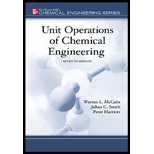
(a)
Interpretation:
The type of flow (laminar or turbulent) for the following condition is to be determined:
Water flowing at an average velocity of 2 m/s in a 100-mm pipe at
Concept Introduction:
In fluid flow, the Reynolds number
For the
For the
For the
The mathematical expression of Reynolds number is,
(a)
Answer to Problem 3.1P
The type of flow for the given condition is turbulent.
Explanation of Solution
The Reynolds number is used to determine the type of flow for the given condition.
The Reynolds number is the ratio inertia forces to viscous forces and it is dimensionless.
The Reynolds number is given as:
Here,
The diameter of the pipe is
Convert the unit of diameter from
The density of the water at
The viscosity of the water at
Average velocity is
Plugin the values in equation (1)
Calculated
(b)
Interpretation:
The type of flow (laminar or turbulent) for the following condition is to be determined:
air flowing at 50 ft/s in a 12-in. duet at 2-atm and
Concept Introduction :
In fluid flow, the Reynolds number
For the
For the
For the
The mathematical expression of Reynolds number is,
The formula for calculating density of air is,
(b)
Answer to Problem 3.1P
The type of flow for the given condition is turbulent.
Explanation of Solution
The Reynolds number is used to determine the type of flow for the given condition.
The Reynolds number is the ratio inertia forces to viscous forces and it is dimensionless.
The Reynolds number is given as:
Here,
The diameter of the pipe is
Convert the unit of diameter from
The temperature at which air is flowing is
Convert the unit of temperature from
The density of the air is calculated as follows:
The value of universal gas constant is
The value of pressure is
The molecular weight of air is
The formula for calculating the density of air is,
Plugin the values in equation (2)
The viscosity of the water at
The velocity is
Convert the unit of velocity from
Plugin the values in equation (1)
The calculated
(c)
Interpretation:
The type of flow (laminar or turbulent) for the following condition is to be determined:
Oil with viscosity of 20 cP flowing at 5 ft/s in a 2-in. pipe with a specific gravity of 0.78.
Concept Introduction :
In fluid flow, the Reynolds number
For the
For the
For the
The mathematical expression of Reynolds number is,
The specific gravity of the oil is given. The formula for calculating the density of oil is,
(c)
Answer to Problem 3.1P
The type of flow for the given condition is transient.
Explanation of Solution
The Reynolds number is used to determine the type of flow for the given condition.
The Reynolds number is the ratio inertia forces to viscous forces and it is dimensionless.
The Reynolds number is given as:
Here,
The diameter of the pipe is
Convert the unit of diameter from
The specific gravity is the ratio of density of liquid to the density of water.
The density of the oil is calculated as follows:
The viscosity of the oil is
Convert the unit of viscosity from
The velocity is
Convert the unit of velocity from
Plugin the values in equation (1)
The calculated
(d)
Interpretation:
The type of flow (laminar or turbulent) for the following condition is to be determined:
Polymer (density = 900 kg/m3and viscosity 1 Pa.s) melts and flowing at 0.2 m/s in a 15-mm tube.
Concept Introduction:
In fluid flow, the Reynolds number
For the
For the
For the
The mathematical expression of Reynolds number is,
(d)
Answer to Problem 3.1P
The type of flow for the given condition is laminar.
Explanation of Solution
The Reynolds number is used to determine the type of flow for the given condition.
The Reynolds number is the ratio inertia forces to viscous forces and it is dimensionless.
The Reynolds number is given as:
Here,
The diameter of the pipe is
Convert the unit of diameter from
The density of the polymer melt is
The viscosity of the polymer melt is
The velocity is
Plugin the values in equation (1)
Calculated
Want to see more full solutions like this?
Chapter 3 Solutions
Unit Operations of Chemical Engineering
 Introduction to Chemical Engineering Thermodynami...Chemical EngineeringISBN:9781259696527Author:J.M. Smith Termodinamica en ingenieria quimica, Hendrick C Van Ness, Michael Abbott, Mark SwihartPublisher:McGraw-Hill Education
Introduction to Chemical Engineering Thermodynami...Chemical EngineeringISBN:9781259696527Author:J.M. Smith Termodinamica en ingenieria quimica, Hendrick C Van Ness, Michael Abbott, Mark SwihartPublisher:McGraw-Hill Education Elementary Principles of Chemical Processes, Bind...Chemical EngineeringISBN:9781118431221Author:Richard M. Felder, Ronald W. Rousseau, Lisa G. BullardPublisher:WILEY
Elementary Principles of Chemical Processes, Bind...Chemical EngineeringISBN:9781118431221Author:Richard M. Felder, Ronald W. Rousseau, Lisa G. BullardPublisher:WILEY Elements of Chemical Reaction Engineering (5th Ed...Chemical EngineeringISBN:9780133887518Author:H. Scott FoglerPublisher:Prentice Hall
Elements of Chemical Reaction Engineering (5th Ed...Chemical EngineeringISBN:9780133887518Author:H. Scott FoglerPublisher:Prentice Hall
 Industrial Plastics: Theory and ApplicationsChemical EngineeringISBN:9781285061238Author:Lokensgard, ErikPublisher:Delmar Cengage Learning
Industrial Plastics: Theory and ApplicationsChemical EngineeringISBN:9781285061238Author:Lokensgard, ErikPublisher:Delmar Cengage Learning Unit Operations of Chemical EngineeringChemical EngineeringISBN:9780072848236Author:Warren McCabe, Julian C. Smith, Peter HarriottPublisher:McGraw-Hill Companies, The
Unit Operations of Chemical EngineeringChemical EngineeringISBN:9780072848236Author:Warren McCabe, Julian C. Smith, Peter HarriottPublisher:McGraw-Hill Companies, The





